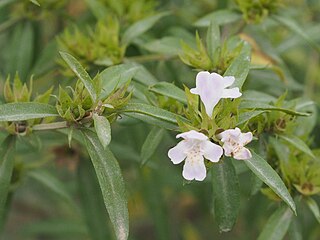
Westringia is a genus of Australian shrubs. As with other members of the mint family their upper petal is divided into two lobes. There are four stamens - the upper two are fertile while the lower two are reduced to staminodes. The leaves are in whorls of 3 or 4.
Westringia senifolia, commonly known as alpine westringia, is a shrub that is endemic to Victoria, Australia.
Westringia cremnophila, commonly known as Snowy River westringia, is a flowering plant in the family Lamiaceae, a rare shrub that is endemic to Victoria, Australia. It is a small shrub with leaves mostly in groups of three and white flowers.

Westringia eremicola, commonly known as slender westringia or slender western rosemary, is a flowering plant in the family Lamiaceae and is endemic to eastern Australia. It is a small shrub, with narrow leaves and pink, mauve to white flowers.

Westringia dampieri, commonly known as shore westringia, is a flowering plant in the family Lamiaceae, it grows in South Australia and Western Australia. It is a small, dense shrub with white, mauve, cream or purple flowers.

Westringia rigida is a shrub in the Lamiaceae family that is endemic to Australia. and

Westringia kydrensis, also known as the Kydra Westringia, is a species of plant in the mint family that is endemic to Australia.

Westringia saxatilis is a species of plant in the mint family that is endemic to Australia.

Westringia davidii, also known as David's Westringia, is a species of plant in the mint family that is endemic to Australia.

Westringia tenuicaulis, also known as the Tufted Westringia, is a species of plant in the mint family that is endemic to Australia. Its natural range is restricted to the Fraser Coast Region of south-eastern Queensland, between Bundaberg and Sippy Downs.

Westringia amabilis is a species of flowering plant in the family Lamiaceae and grows in New South Wales and Queensland. It is a small shrub with ovate-shaped leaves and light mauve to white flowers and brownish spots in the throat.

Westringia parvifolia is a species of plant in the mint family that is endemic to Australia.

Westringia lucida, also known as Shining Westringia, is a species of plant in the mint family that is endemic to Australia.

Westringia rupicola is a species of plant in the mint family that is endemic to Australia.

Westringia rubiifolia, also known as sticky westringia, is a species of plant in the mint family that is endemic to the Australian state of Tasmania.

Westringia ophioglossa is a species of plant in the mint family that is endemic to Western Australia.

Westringia fitzgeraldensis is a species of plant in the mint family that is endemic to Western Australia.

Westringia cheelii is a species of plant in the mint family that is endemic to Australia.

Westringia capitonia is a species of plant in the mint family that is endemic to Western Australia.

Westringia acifolia is a flowering plant in the family Lamiaceae and is endemic to Western Australia. It is a compact shrub with linear to needle-shaped leaves and white to cream flowers.



















